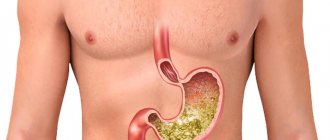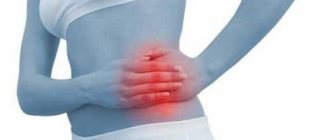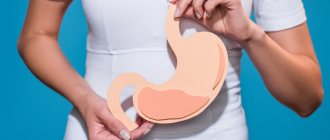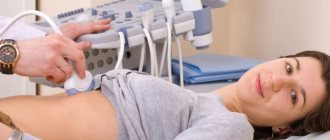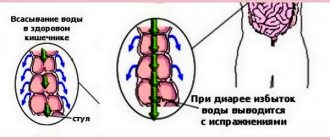What is stomach pain
Pain in the stomach area is called gastralgia.
It can be caused by many factors. These include serious pathologies of internal organs and minor temporary ailments, for example, after eating too much. Pain in the stomach is easily confused with unpleasant sensations in other organs located in the abdominal cavity and retroperitoneal space:
- small and large intestines,
- kidneys,
- appendix,
- spleen,
- gallbladder,
- liver,
- pancreas.
Often, stomach pain is accompanied by other symptoms of gastrointestinal disorders - nausea, vomiting, diarrhea.
How does my stomach hurt?
To determine that it is the stomach that hurts, you need to understand its anatomy. The stomach is located in the abdominal cavity just below the diaphragm. Its shape and size constantly change depending on the amount of food eaten. The largest part of the organ is located on the left directly under the ribs, and the smaller part is located immediately under the sternum (Fig. 1). This area is called the epigastric region.
Figure 1. Where is the stomach in the human body. Source: MedPortal
Adjacent to the posterior wall of the stomach are the pancreas, spleen and the upper part of the left kidney.
Pain in the stomach is usually localized in the upper abdomen - the epigastrium, but in the same area pain can appear with pancreatitis, cholelithiasis, and even with myocardial infarction and aortic aneurysm (Fig. 2).
Figure 2. Cause of pain depending on location. Source: MedPortal
Acute and severe “dagger” pain is characteristic of perforation of a stomach ulcer and peritonitis. In case of indigestion, the pain is localized on the left under the ribs; a sign of chronic gastritis with low acidity is pain in the middle of the abdomen; if the body of the stomach is affected, complaints are associated with painful sensations above the navel.
But the localization of pain is not an unambiguous sign of stomach diseases. For example, pain in the left side of the abdomen often occurs with osteochondrosis and cardiovascular pathologies. In women, such pain can appear due to pathologies of the ovaries and uterus.
The most likely sign of stomach problems is pain that appears after eating or during a long break between meals. But even in this case, its cause can be established only after a comprehensive examination.
Other causes of pain in the abdomen
With acute and sharp cutting pain, an ulcer may be detected.
Cutting pains do not always lead to dire consequences, but in any case it is a serious symptom hinting at pathological processes in the body. In a healthy person, such sensations occur extremely rarely. There are several reasons why pain may occur:
- Severe pain in the lower abdomen, accompanied by severe diarrhea and nausea, as well as a fever, is usually a sign of an intestinal infection. Some of them can be quite dangerous. This condition requires examination and immediate treatment. It is imperative to undergo diagnostics and identify the causative agent of the disease in order to select the most effective treatment.
- Cholecystitis can also provoke severe pain. An inflamed gallbladder often leads to pain. The inflammation is usually caused by an infection. Pain and cramps usually occur in the right side, but higher than with appendicitis. An attack of sharp pain can begin a couple of hours after eating if there have been dietary violations (fatty, fried foods, alcohol) or after shaking in transport, stress or heavy physical exertion.
- Abdominal pain can be caused by worms. Parasites, entering the human body, cause various disruptions in the functioning of the gastrointestinal tract. Worms poison the body with toxic substances. The larger the infection, the worse the pain and diarrhea. Worms multiply and grow. If the parasites are large enough, they can block the intestinal lumen, which is also accompanied by pain. In addition to the gastrointestinal tract, the nervous system also suffers, headaches and weakness appear.
- In women, such pain can mean problems with the genital area. This could be a miscarriage, ectopic pregnancy or other dangerous conditions. In an ectopic pregnancy, the egg does not reach the uterus and remains in the fallopian tube. As the embryo grows, the tube expands and can rupture, causing the egg to enter the abdominal cavity, which causes severe inflammation. In most cases, the pipe does not burst, since severe pain and bleeding force the pregnant woman to see a doctor.
- A follicular ovarian cyst is also accompanied by severe pain in the lower abdomen. Each menstrual cycle in a woman is accompanied by the maturation of follicles, one of which then serves as the basis for the maturation of the egg. The egg is then released from the ruptured follicle. If this does not happen, the follicle with the egg becomes a cyst and increases in size. In this case, prolonged bleeding and severe pain occur.
Why does my stomach hurt?
Stomach pain can be caused by situational reasons that do not threaten human health, and by very serious pathologies of internal organs.
Situational factors include:
- Flatulence (bloating) is a condition in which gases accumulate in the stomach, distending the organ from the inside and causing pain. The accumulation of gases is usually associated with poor nutrition and a sedentary lifestyle.
- Constipation. The causes of constipation are mainly associated with eating large amounts of fatty foods and baked goods, a lack of fresh fruits and vegetables in the diet, and physical inactivity.
- Premenstrual syndrome often causes pain that is similar in nature and location to stomach pain.
- Irritable bowel syndrome and other functional disorders of the digestive tract.
- Sprains during pregnancy.
Pain caused by situational factors is temporary and goes away fairly quickly without the help of a doctor or taking medications. Prolonged pain is a signal indicating serious health problems.
Diseases that cause stomach pain:
- Gastritis is an acute or chronic inflammation of the gastric mucosa, the most common cause of pain. The disease is most often caused by the bacterium Helicobacter pylori. Exacerbation of pathology and severe pain in the stomach can be associated with improper eating behavior, nervous strain, and taking certain medications.
- Stomach and duodenal ulcers occur against the background of chronic gastritis, problems with blood supply to the gastric mucosa and some other diseases. The ulcer manifests itself as pain in the stomach during long breaks between meals and at night (hunger pain).
- Pancreatitis is inflammation of the pancreas. Pancreatic juice secreted by the gland neutralizes hydrochloric acid. If there is insufficient juice production, the acid irritates the gastric mucosa, causing pain.
- Crohn's disease is a chronic inflammatory process in all parts of the intestine.
- Cholecystitis is inflammation of the gallbladder. Disturbance in the process of bile outflow is one of the causes of inflammation of the gastric mucosa and pain.
- Damage to the gastric mucosa by the bacterium Helicobacter pylori and other types of pathogenic microflora. Gastritis and stomach ulcers often develop as a result of infectious diseases of the digestive system.
- Stomach tumors of any etiology. Severe pain is one of the symptoms of stomach cancer, but it can also be caused by benign formations - polyps, lipomas, neuromas and others.
Pain can also be caused by diseases not related to the stomach itself: acute appendicitis, colitis, spasm of the diaphragm, thrombosis of intestinal vessels, coronary heart disease and others (Fig. 3).
Figure 3. Causes of pain in the upper and lower abdomen. GERD is gastroesophageal reflux disease. Source: verywellhealth.com
Stomach pain in women
Women often experience stomach pain during pregnancy for various reasons.
Firstly, due to an increase in progesterone levels, the intestinal muscles relax, and the time it takes for food to pass through it increases, which leads to flatulence. Secondly, the uterus, increasing in size, puts pressure on the digestive organs, slowing down the process of food digestion. During pregnancy, stomach pain can also be associated with constipation, the causes of which are hormonal fluctuations, insufficient physical activity, nervous tension, and dietary habits.
Acute pain in the stomach in women can be a signal to immediately call an ambulance, as its cause can be an ectopic pregnancy, preeclampsia, miscarriage and placental abruption.
Cutting pain as a symptom of disease
Pancreatitis is a disease in which there is inflammation of the pancreas.
Any pain is an alarming sign, especially if it occurs suddenly and causes severe discomfort. Cutting pains may indicate the following serious diseases:
- Attack of appendicitis. Inflammation of the appendix is a serious condition that requires immediate surgical intervention. Abdominal cramps, the causes of which lie in inflammation of the appendix, always begin with pain in the center, and then go lower and flow to the right side. It is worth paying close attention to these symptoms. A person in this condition must be hospitalized. You should not rejoice at the relief, since it may mean that the appendix has ruptured, which leads to very serious complications, even death.
- Pancreatitis during exacerbation. During an exacerbation, pancreatitis can easily be confused with appendicitis, but cramps in the abdomen almost never flow to the right side; they are rather of a girdling nature. The pain can be even more excruciating than with appendicitis. The patient also suffers from nausea, the pain intensifies when pressing on the abdomen. In this condition, it is also recommended to call an ambulance. You can not only confuse appendicitis and pancreatitis, but also miss complications due to inflammation of the pancreas. In severe cases, it also requires surgical intervention.
- Gastritis. Gastritis in any form is accompanied by pain and discomfort. As a rule, the stomach hurts, but the duodenum and pancreas can also become inflamed. In acute gastritis, cutting pain begins after a hearty lunch. There is a feeling of heaviness. Acute gastritis must be treated as early as possible so that it does not become chronic.
- Ulcer. If the pain in the abdomen is unbearably strong, there is a feeling that the stomach is literally being cut with a knife, this is an alarming sign of perforation of the ulcer. It breaks through very quickly, every second is important. Delay may result in the death of the patient. The only possible treatment remains surgery. If the ulcer has not broken through, the pain will not be so intense and will subside after eating. Usually the ulcer is accompanied by diarrhea, belching, flatulence, and a feeling of a full stomach.
Types of stomach pain
Stomach pain varies significantly in nature and intensity depending on the causes that caused it. An accurate description of the pain syndrome greatly facilitates the diagnosis of pathology. But it must be remembered that the same factor can cause pain of varying intensity and nature. Our test will help you understand the causes of your own pain.
Acute pain
Acute severe cramps in the stomach are a sign of the development of a pathological process.
The attacks usually pass quickly, but recur after a short period of time. The intensity of pain attacks depends on the degree of damage to organs and tissues. Acute pain requires immediate consultation with a doctor, as the causes that cause it can lead to a tragic outcome. This symptom is typical for:
- acute gastritis,
- poisoning with food, chemicals and toxic substances,
- infectious damage to internal organs,
- peptic ulcer,
- acute pancreatitis and cholecystitis,
- acute appendicitis.
Acute stomach pain is often accompanied by nausea and vomiting. In addition to stomach diseases, acute epigastric pain can be caused by pulmonary pathologies, diseases of the diaphragm, cardiovascular system, in particular myocardial infarction.
Self-medication for acute stomach pain is contraindicated; the diagnosis can only be made by a doctor after a full examination.
Strong
Severe pain occurs with acute gastritis, irritable bowel syndrome, poisoning, stomach and duodenal ulcers, and acute pancreatitis.
To correctly diagnose the causes of severe pain, the presence of accompanying symptoms is important. Nausea and vomiting are signs of acute gastritis, poisoning, biliary colic. Peptic ulcer disease is accompanied by heartburn and sour belching, irritable bowel syndrome - diarrhea and flatulence.
The intensity of pain is a rather subjective sensation, so a full examination is necessary for a correct diagnosis.
Sharp
Sharp pain may be a sign of aggressive chemicals entering the stomach, such as acids or alkalis. Spoiled food also causes burns to the gastric mucosa.
Such pain in the area above the navel is a symptom of acute appendicitis. In addition, sharp pain sometimes occurs with neoplasms in the stomach and pancreas, with complications of peptic ulcer disease, when adhesions develop in adjacent tissues.
cutting
A dull cutting pain is characteristic of acute pancreatitis. If the pain covers the entire abdomen, and severe pain is felt in the epigastric region, then with a high degree of probability it can be assumed that the ulcer has perforated. Any movement in this case causes increased pain, so the person takes the “fetal position”, bending his knees and pressing them to his chest.
Cramps in the stomach can be triggered by taking certain medications, for example, non-steroidal anti-inflammatory drugs and antipyretics.
Aching
Aching pain after eating is a sign of increased acidity of gastric juice. Such pain often occurs due to indigestion, poor diet, or eating too much food.
The cause of aching pain may be chronic gastritis, a stomach ulcer outside the period of exacerbation, infection or a malignant tumor. The stomach aches after alcohol abuse, overeating, or eating stale foods.
Pulling
Nagging pain often occurs in pregnant women due to pressure on the digestive organs by the increasing size of the uterus. Similar sensations are familiar to most nursing mothers. Such pain can also occur with gastritis and cholecystitis.
Constant pain
Constant pain is often present with advanced gastric cancer. Such complaints also arise with advanced gastritis, stomach ulcers and other inflammatory diseases. Constant pain in the stomach can be a consequence of prolonged stress, alcohol abuse, or poor diet.
Periodic pain
Periodic pain may not be associated with gastric pathologies and go away without medical intervention. Sometimes abdominal pain occurs after eating unusual food, with bloating or constipation.
Pain before eating
Pain after a long break from eating is characteristic of a duodenal ulcer. Also, if pain occurs on an empty stomach, one can assume the presence of an inflammatory process on the mucous membrane - gastritis or gastroduodenitis.
Nausea and pain
The combination of such symptoms is typical for food poisoning, taking large doses of alcohol, and consuming fatty foods. Nausea and stomach pain often bother women in the first trimester of pregnancy. A similar condition can occur due to stress and certain neurological disorders.
Night stomach pain
Most often at night, the stomach hurts due to irritation of the mucous membrane with hydrochloric acid and pepsin, an enzyme of gastric juice. Night pain can be a consequence of overeating during dinner, prolonged stress, excessive physical activity and inflammatory processes in the stomach.
Stomach pain due to coronavirus
Stomach pain is not a typical symptom of COVID-19, but in rare cases, problems in the digestive system begin when the virus enters the body through the oral-fecal route.
About 10% of those infected experience nausea, vomiting, diarrhea and stomach pain. In isolated cases, the disease occurs with symptoms similar to those of serous peritonitis. Stomach pain with coronavirus is typical for young patients.
Anterior cutaneous nerve entrapment syndrome as a cause of abdominal pain
Abdominal pain or abdominal pain is a common reason for patients seeking medical help. Over a 5-year follow-up period, up to half of individuals experience abdominal pain.
There are several types of abdominal pain:
1) visceral - associated with damage to internal organs, most often the digestive organs. It is characterized by unclear localization, i.e. the pain zone only approximately corresponds to the affected zone. This pain is often associated with eating, defecation, etc.
2) parietal - occurs when the parietal peritoneum is involved in the process of inflammation. The pain is usually clearly localized, sharp, cutting, stabbing, and is accompanied by symptoms of peritoneal irritation.
3) referred pain - occurs when several zones are innervated by one segment of the spinal cord. For example, abdominal pain can occur with myocardial infarction.
4) projection pain - occurs when nerves are damaged, and the place of pain perception corresponds to the zone innervated by this nerve.
This article will discuss one of the diseases that is characterized by projection pain, namely anterior cutaneous nerve entrapment syndrome . It is also called rectus abdominis syndrome. In the English-language medical literature, the term ACNES is used (anterior cutaneous nerve entrapment syndrome, which translated into Russian means anterior cutaneous nerve entrapment syndrome), which we will use further in this article.
ACNES is one of the common causes of abdominal pain that remains unrecognized. On average, the prevalence of this syndrome is 1:1800-2000. In adolescents, one out of eight cases of chronic abdominal pain is caused by anterior cutaneous nerve entrapment syndrome. Up to 2% of cases of patients visiting a hospital emergency room with acute abdominal pain are caused by ACNES.
Pathogenesis of ACNES.
In ACNES, the lower thoracoabdominal intercostal nerves (Th8-Th12) are involved in the pathological process. They pass between the internal oblique and transverse abdominis muscles to the point where they reach the rectus abdominis muscles. Here the nerves turn to enter the rectus abdominis channels. It is assumed that compression of the nerves in the rotation zone is the leading mechanism for the development of ACNES. Pinching occurs due to muscle contraction, which can cause additional compression of the nerve, its ischemia, and, as a result, leads to severe pain.
Clinical picture of ACNES.
Pain (dull or sharp) is usually localized in a certain area - along the edge of the rectus abdominis muscle in the umbilical region or in the right hypochondrium. The pain is usually chronic, constant or frequent, less often in the form of individual episodes. The area of pain in most cases can be easily identified by palpation in the painful area. In rare cases, when the ilioinguinal and iliohypogastric nerves (Th12-L1) are pinched, the pain may have an atypical localization: in the iliac region and groin. Localization of pain in the right hypochondrium can simulate an attack of biliary colic.
The pain may vary depending on the person's posture, worsening when lying on the side of pain or sitting. Pain sensations are reduced when lying on your back. Coughing, laughing, bumpy driving, running, wearing tight belts and corsets, as well as exercise lead to increased abdominal pain.
Diagnosis of ACNES.
Diagnostic criteria for anterior cutaneous nerve entrapment syndrome include the following:
1) Unilateral localized pain in the abdominal wall lasting at least 1 month;
2) The presence of a unilateral painful area (“trigger point”) on the anterior abdominal wall measuring about 2 cm2, detected by pressing the index finger along the lateral border of the rectus abdominis muscle;
3) Positive Carnett's sign. Carnett's sign, named after the scientist who described it in 1926, involves the examiner identifying the exact location of maximum tenderness on the abdominal wall and asking the patient to elevate the head and/or torso with the arms crossed over the chest. Increased pain or persistent pain during this movement indicates that the cause of the pain is located in the abdominal wall (positive Carnett's sign). On the contrary, a negative Carnett symptom indicates another cause of pain (for example, pathology of the internal organs);
4) Positive “pinch” test: when fingers grasp a fold of skin and subcutaneous tissue, local pain is detected;
5) A change in the tactile sensitivity of the skin in response to a light touch and/or a change in the temperature sensitivity of the skin with a decrease in the perception of cold in the area of the most severe pain;
6) Normal laboratory data (no signs of inflammation or infection) in the absence of a surgical cause of pain;
7) Absence of pathology according to imaging studies (including ultrasound, computed tomography);
A temporary reduction in pain by at least 50% after injection of a local anesthetic (usually lidocaine) at the trigger point.
Differential diagnosis of ACNES
The differential diagnosis includes various diseases in order to exclude other causes of chronic abdominal pain. The examination may reveal cicatricial changes in the skin, causing irritation and pinching of nerves, as well as hernias of the anterior abdominal wall (including those with signs of pinching).
In most cases, a thorough clinical and laboratory examination is required to exclude pathology of the abdominal organs.
Differential diagnosis with functional diseases of the digestive system, for example, irritable bowel syndrome (IBS) and functional abdominal pain, seems more difficult. Since there are no special research methods to diagnose these diseases, the doctor has to focus on typical clinical manifestations. Even ex juvantibus diagnosis (a diagnosis based on an assessment of the results of treatment) does not help, since therapy is not effective in all patients with IBS. The ACNES Questionnaire was developed to help differentiate functional bowel pain from pain caused by anterior cutaneous nerve entrapment syndrome. An index value of more than 10 points makes the diagnosis of functional abdominal pain unlikely.
ACNES therapy.
Treatment of anterior cutaneous nerve entrapment syndrome includes several approaches:
1) Systemic therapy - the use of non-steroidal anti-inflammatory drugs, weak opioid analgesics (tramadol), paracetamol, antiepileptic drugs (gabapentin) and antidepressants (amitriptyline). Unfortunately, therapy with these drugs, which often helps with other types of neuropathic pain, is usually ineffective in the case of ACNES.
2) Local therapy:
A. Trigger point injections. The trigger point in ACNES is the site of a pinched nerve, so injection of a local anesthetic into this area has both a therapeutic and (in complex cases) diagnostic effect. A 1% solution of lidocaine (10 ml) with or without the addition of steroid hormones is usually used as an anesthetic. The effect of treatment is defined as a reduction in pain severity by 50% or more, and the duration of the effect usually exceeds the half-life of the drug. The addition of steroid hormones may result in more durable pain relief, possibly due to their anti-inflammatory effects and attenuation of nerve excitation. However, their use is often associated with side effects, mainly abdominal muscle atrophy and systemic adverse reactions.
The blind method of administering anesthetic may result in an incorrect injection zone, as a result of which the use of ultrasound guidance has recently been recommended. The use of an ultrasound machine allows lidocaine to be injected precisely into the affected area, avoiding complications (entry into the abdominal cavity).
B. Chemical neurolysis. The literature describes the effect of 96% ethyl alcohol or 5-6% phenol solution for chemical destruction of pinched nerve fibers. However, there is no data on the long-term effectiveness and safety of this method.
B. Radiofrequency ablation is the treatment of nerves or nerve ganglia with high-frequency electrical impulses.
D. Ultrasound-guided injection of botulinum toxin into the trigger zone has been studied as an alternative technique, but there is no data on the long-term effectiveness of this method.
3) Surgery:
A. Laparoscopic anterior neurectomy - removal of a section of a pinched nerve.
B. Using a reinforcing polytetrafluoroethylene mesh over the problem area to prevent compression of the nerve.
When to see a doctor?
Any pain in the stomach requires consultation with a gastroenterologist, but in some cases it is necessary to immediately call an ambulance (Fig. 4). You should immediately consult a doctor if you have the following symptoms:
- severe pain after injury;
- heat;
- bloody stools;
- constant nausea and vomiting;
- sudden weight loss;
- yellow skin;
- pain when touching the stomach.
Figure 4. When stomach pain is a medical emergency.
Source: MedPortal Important! Stomach cancer often, although not always, is accompanied by specific symptoms:
- Rectal bleeding, traces of blood in the stool,
- Persistent lack of appetite,
- Unexplained weight loss
- Fatigue,
- Heat,
- Anemia.
Diagnostics
Diagnosis is aimed at finding out the causes of stomach pain and identifying the underlying disease.
First of all, the gastroenterologist collects anamnesis, finding out:
- localization of pain - the entire abdomen or limited to a certain area;
- the nature of the pain - stabbing, cutting, constant, periodic, etc.;
- when the pain appears: in the morning or evening, before or after meals, duration of the attack, connection with alcohol or certain foods;
- does the pain radiate to other organs;
- what medications are taken;
- is there any pregnancy;
- whether there were abdominal injuries.
Depending on the medical history, instrumental and laboratory research methods are prescribed:
- Ultrasound of the abdominal organs;
- endoscopy of the stomach;
- radiography;
- pH-metry;
- stool analysis.
How to treat
Therapy for stomach pain is aimed at treating the underlying disease.
Conservative treatment includes relief of symptoms, pain relief and removal of toxins.
Surgical treatment is prescribed if there is no effect from taking medications and if malignant tumors are detected.
First aid for stomach pain
If you have stomach pain, it is better to stop eating for a while and lie down quietly.
You should not immediately take painkillers, as they can irritate the mucous membranes and aggravate the condition. If you have stomach pain:
- replace food with warm drinks and low-fat broth;
- you need to lie down, pressing your knees to your stomach as much as possible;
- place a cold towel on your stomach;
- massage your stomach in a circular motion;
- in case of poisoning, take activated carbon or other absorbents;
- drink as much plain, clean water as possible.
Seek medical help as soon as possible.
Drugs
The choice of medications is determined by the cause of stomach pain. The doctor may prescribe:
- antisecretory agents that reduce acidity;
- antacids that neutralize the stomach environment;
- antispasmodics to relieve pain;
- prokinetics to stimulate intestinal motility;
- gastroprotectors to protect the gastric mucosa from aggressive influences.
Only a doctor can select a treatment regimen based on the results of the examination.
Diet
Any pain in the stomach requires a gentle diet. There is no need to force yourself to eat if you have no appetite.
You should eat regularly, avoid spicy, smoked and fried foods, do not eat too hot food, and be sure to have breakfast. The best foods for stomach pain are bananas, rice, applesauce, and toast (Figure 5).
Figure 5. Diet rules for stomach pain. Source: MedPortal
Folk remedies
For stomach pain, decoctions and infusions of berries and vegetables help well:
- gooseberry infusion (pour a few glasses of water over the berries and boil for 15 minutes, drink every 2 hours),
- potato juice (three times a day before meals),
- rowan infusion (one tablespoon before meals),
- white cabbage juice, cucumber, pomegranate, quince juice (drink before meals),
- decoction of crushed oats,
- rye bran infusion,
- dandelion syrup,
- infusion of dill seeds,
- white mistletoe decoction.
Pharmacies offer a wide range of herbal teas to normalize stomach function, but before using any herbal remedy, you should consult your doctor.

